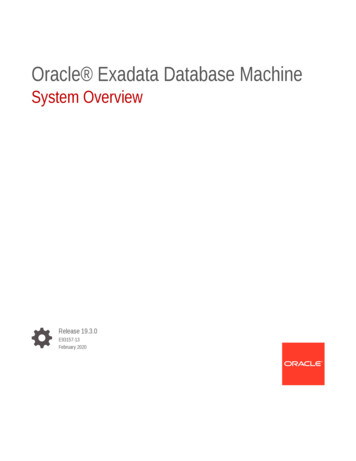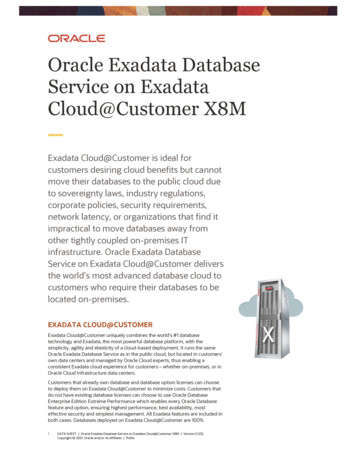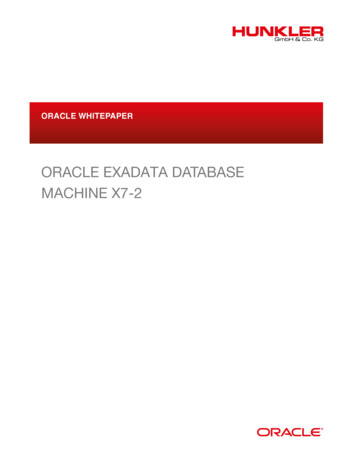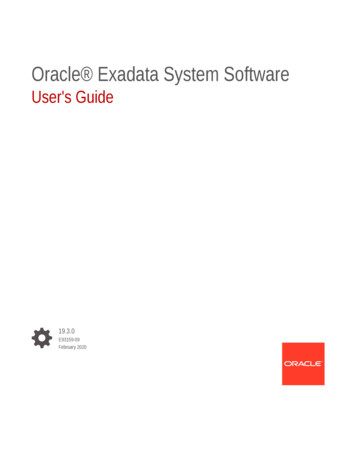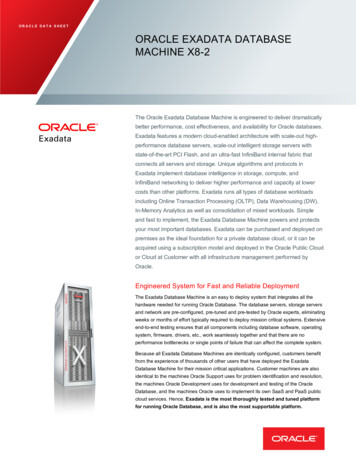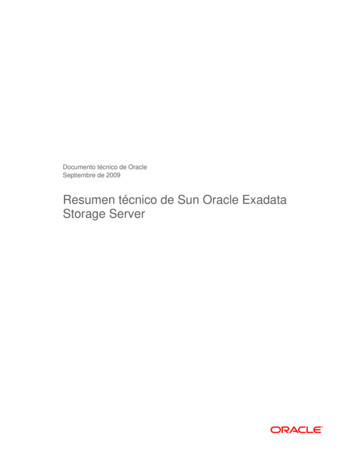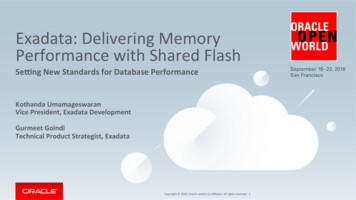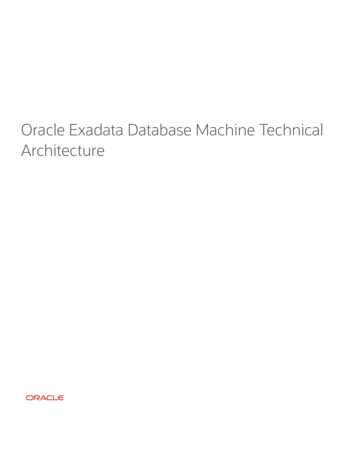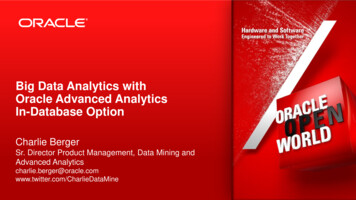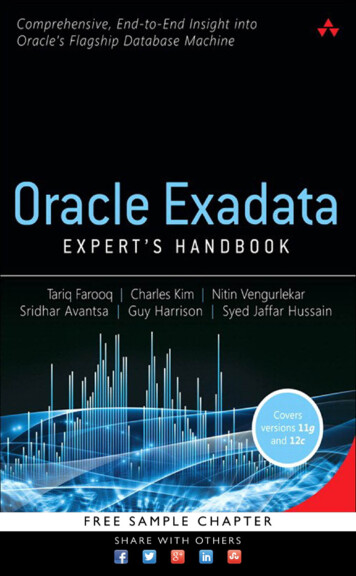
Transcription
Oracle ExadataExpert’s Handbook
This page intentionally left blank
Oracle ExadataExpert’s HandbookTariq FarooqCharles KimNitin VengurlekarSridhar AvantsaGuy HarrisonSyed Jaffar HussainNew York Boston Indianapolis San FranciscoToronto Montreal London Munich Paris MadridCapetown Sydney Tokyo Singapore Mexico City
Many of the designations used by manufacturers and sellers to distinguish their products are claimed astrademarks. Where those designations appear in this book, and the publisher was aware of a trademark claim,the designations have been printed with initial capital letters or in all capitals.The authors and publisher have taken care in the preparation of this book, but make no expressed or impliedwarranty of any kind and assume no responsibility for errors or omissions. No liability is assumed for incidental or consequential damages in connection with or arising out of the use of the information or programscontained herein.For information about buying this title in bulk quantities, or for special sales opportunities (which may includeelectronic versions; custom cover designs; and content particular to your business, training goals, marketingfocus, or branding interests), please contact our corporate sales department at corpsales@pearsoned.com or(800) 382-3419.For government sales inquiries, please contact governmentsales@pearsoned.com.For questions about sales outside the U.S., please contact international@pearsoned.com.Visit us on the Web: informit.com/awLibrary of Congress Control Number: 2015935451Copyright 2015 Pearson Education, Inc.All rights reserved. Printed in the United States of America. This publication is protected by copyright, andpermission must be obtained from the publisher prior to any prohibited reproduction, storage in a retrievalsystem, or transmission in any form or by any means, electronic, mechanical, photocopying, recording, orlikewise. To obtain permission to use material from this work, please submit a written request to PearsonEducation, Inc., Permissions Department, 200 Old Tappan Road, Old Tappan, New Jersey 07675, or you mayfax your request to (201) 236-3290.Various screen shots and illustrations of Oracle products are used with permission. Copyright 1995–2014Oracle and/or its affiliates. All rights reserved.ISBN-13: 978-0-321-99260-4ISBN-10: 0-321-99260-1Text printed in the United States on recycled paper at RR Donnelley in Crawfordsville, IndianaFirst printing, June 2015
ContentsPrefacexviiAcknowledgmentsxixAbout the AuthorsxxiiiAbout the Technical Reviewers and ContributorsxxviiChapter 1360-Degree Overview of Exadata1An Exadata Synopsis2An Engineered Database Machine3How Exadata Changes Your Job Role4Oracle Enterprise Manager 12c4Hardware Architecture5Server Layer—Compute Nodes5Shared Storage—Storage Cells6Networking Fabric—InfiniBand6Power Distribution Units (PDUs)7Cisco Switch72u Custom Network Switch Space7v
viContentsSoftware ArchitectureReal Application Clusters (RAC)7Automatic Storage Management (ASM)8DB Compute Nodes9Storage Cell Software9Models and Configuration OptionsChapter 279Historical Synopsis10The Evolution of Exadata10Exadata SuperCluster T4-425Exadata SuperCluster T5-827Exadata SuperCluster M6-3229Exadata Storage Expansion Racks31Exadata Storage Cells33Hardware Progression33Examining an Exadata Machine35Summary37Real Application Clusters (RAC) in Exadata39The Significance of RAC in Exadata40An Overview of RAC41A Quick Primer on RAC in Exadata42How RAC Affects DBAs42Setting Up RAC Clusters in Exadata43Operational Best Practices45Maximum Availability Architecture (MAA)45Optimal and Efficient Databases in RAC46Managing RAC with OEM 12c49Common Utilities and Commands50Troubleshooting and Tuning RAC55Start with ORAchk55Employ the TFA Collector Utility56Use the Automatic Diagnostic Repository56Check the Alert and Trace Log Files56Employ the Three As56
ContentsChapter 3viiCheck the Private Cluster Interconnect57Enable Tracing and Inspect the Trace Logs57Cluster Health Monitor57Employ Oracle Enterprise Manager 12c57Miscellaneous Tools and Utilities58Useful Oracle Support Resources58Summary59The Secret Sauce: Exadata Storage Cells61An Overview of Exadata Storage Server61Storage Server Architecture63Cell Software Components and Management64Configuring Mail Server for Alert Notifications68Displaying Cell Server Details68Cell Metrics and Alert History69Querying Cell Alert History70Querying GV Views71Storage Architecture and Formulation72Disk Architecture in Non-Exadata74Disk Architecture in Exadata74System Users for Cell Administration77Listing Disk Levels77Configuring Cell Disks81Creating Grid Disks81Configuring Flash Grid Disks81Creating an ASM Disk Group82Managing the Cell Server82Troubleshooting the Cell file85Storage Cell Startup and Shutdown85Solving Disk Problems87
viiiContentsEnforcing Cell SecurityChapter 4Configuring ASM-Scoped Security90Configuring Database-Scoped Security91Exempting Cell Security92Summary92Flash Cache, Smart Scans, and Cell Offloading93Concepts of Exadata Flash Cache93Why Flash Cache Is Necessary93Evolution of Flash Cache in Exadata94Storage Server and Flash Cache95The Exadata Smart Flash Cache Feature96Populating the Flash Cache97Exadata Smart Flash Logging98The Database and Flash CacheChapter 58999Smart Scans and Cell Offloading101Storage Indexes107Caching Data in the Flash Cache115Summary120Exadata Compression: HCC Demystified121Columnar Storage Models122The PAX Model124Fractured Mirrors124Fine-Grained Hybrids124Oracle Implementation of DSM—Hybrid Columnar Compression125Compression within Oracle Databases125The Concepts of HCC125Compression Ratios127Compression Types and Compression Units129HCC and Performance131Bulk Load Operations132Bulk Read I/O Operations135Small I/O Operations137
ContentsChapter 6ixHCC and DML140HCC and Locking144Practical Uses of HCC147Summary148Oracle Database 12c and Exadata14912c Partitioning Features149Partial Indexes149Partition Index Maintenance153Partition Move155New 12c Optimizer FeaturesChapter 7157Adaptive Plans157Automatic Re-optimization159Dynamic Adaptive Statistics159Information Lifecycle Management164Application Continuity167Multitenant Architecture168Overview169PDB: A New Consolidation Model169Unplug/Plug Operations177RAC and PDB178Exadata Software Updates183Summary183Exadata Networking: Management and Administration185Exadata Network Components185The Role of the InfiniBand Network186Network Architecture187Network Setup Requirements188Troubleshooting Tools and Utilities190Physical Link Monitoring190Log Files Collection194Integrated Lights Out Manager195OEM Cloud Control 12c197Summary199
xChapter 8ContentsBackup and Recovery and Data Guard201RMAN Disk-to-Disk Backups202Settings for RMAN Backups on the Exadata203rman2disk Shell Scriptrman2disk Template FilesUsing rman2disk204Creating RMAN Backups209RMAN Backup Schedule213Container and Pluggable Databases215206206Data Guard216Patches217Session Data Unit217Bandwidth-Delay Product218Network Queue Size220Disabling TCP Nagle Algorithm221Enabling Network Time Protocol221Block Change Tracking222Fast Recovery Area222Automatic Archive Switch223Parallel Execution Message Size223Database Cache Size224Standby Redo Logs224Force Logging226Flashback Logging227Real-Time Apply227Timeout and Reopen Options228Archive Generation Rate229Standby File Management231Data Guard Standby-First Patching231Active Data Guard232Far Sync233Archive Log Retention Policy233Data Corruptions234Data Guard Instantiation235
ContentsChapter 9xiConfiguring Data Guard Broker239OEM Cloud Control 12c241Switchover Considerations242Switchover Tracing243Guaranteed Restore Point244Summary244Managing Exadata with OEM 12c245Exadata Targets Discovery246Exadata Monitoring Architecture246Oracle Exadata Plugins248Prerequisite Checks249Manual Deployment249Exadata Database Machine Discovery250Prerequisite Checks250Launching Exadata Discovery250Post-Discovery Procedure260Exadata Components260Monitoring and Management261Administration262Summary265Chapter 10 Migrating to Exadata267Exadata Implementation Lifecycle267Phase I: Architectural Strategy268Sizing the Specific Exadata SolutionPhase II: Planning and Design272277Custom versus Third-Party Applications278Choosing Exadata Features to Implement279Accounting for the Paradigm Change279Determining Migration Strategies280Phase III: Migration Testing287Backup and Recovery Strategy288Exadata Monitoring and Alerting289Exadata Patching289
xiiContentsExadata Migration Best Practices290Summary291Chapter 11 Upgrading and Patching Exadata and ZFS StorageAppliancePlanning an Exadata and ZFS UpgradePatch Release Cycle293294296Quarterly Full Stack Download297Patching Tools and Processes297OPatch298patchmgr299OPlan300Oracle Patch Types302Patch Set Updates303Critical Patch Updates and Security Patch Updates304Oracle Patching Standard304One-Off Patches304Exadata High Availability Upgrades305Reviewing Settings with Exachk306Exadata Full Stack Upgrade307Exadata Upgrade Path307Downloading Patches for Exadata and ZFS311Upgrading the Cell Nodes312Updating the Compute Nodes315Updating InfiniBand Switches319Updating Grid Home319Upgrading Ethernet Switches323Upgrading the KVM Switch331Upgrading PDUs332ZFS Upgrade333ZFSSA Configuration and Upgrade333ZFS Update Stage 1334ZFS Update Stage 2334Updating ZFS BIOS335Summary336
ContentsxiiiChapter 12 ZFS Storage Appliance for Exadata337ZFS Family Line338Increased Storage Capacity340Reclaiming Resources and Space from DBFS341Information Lifecycle Management342ZFSSA Browser User Interface342Creating NFS Shares343Preparing Exadata for Direct NFS345Configuring and Mounting the NFS Share348Snapshots349Clones351Snapshots and Clones with Data Guard352Best-Practice Settings on ZFS Share353Other Industry Use Cases355Learning on the Simulator355Summary356Chapter 13 Exadata Performance TuningOracle Performance Tuning357357Systematic Oracle Performance Tuning358Oracle Performance Troubleshooting359Application Design for Exadata362Database Design for Exadata364Storage Indexes365Offloading365Exadata Smart Flash Cache and Indexes366Index Design for New Applications367Indexing Strategy for Existing Applications368Choosing Compression Levels372SQL Tuning for Exadata372Exadata RAC Tuning374Global Cache Basics374RAC Tuning Principles375Cluster Overhead376
xivContentsReducing Global Cache Latency378LMS Latency381Balancing an Exadata RAC Database383Balancing Workloads with IORM and DBRM385Optimizing Exadata I/O386Leveraging Flash More Effectively387Configuring the Write-Back Facility387Configuring ASM387Changing the Block Size388SummaryChapter 14 Database Consolidation on Exadata388389Database Consolidation Models389Exadata Consolidation Planning390Grouping Applications391Server Pools391Chargeback392Evaluating Sizing Requirements393Setting Up Exadata for Consolidation394Storage and I/O Settings394Memory Settings398CPU Settings399Isolation Management405Fault Isolation in Database Consolidation406Fault Isolation in Schema Consolidation406Operational Isolation in Database Consolidation406Operational Isolation in Schema Consolidation407Resource Isolation in Database Consolidation408Resource Isolation in Schema Consolidation408Security Isolation in Database Consolidation409Security Isolation in Schema Consolidation40912c Pluggable Database410Summary411
ContentsxvChapter 15 Exadata Smart Flash Cache in DepthSolid-State Disk Technology413413Limitations of Disk Technology413The Rise of Solid-State Flash Disks415Flash SSD Architecture and Performance417The Oracle Database Flash Cache421Exadata Flash Hardware422Exadata Smart Flash Cache423Exadata Smart Flash Cache Architecture423What the Exadata Smart Flash Cache Stores425Flash Cache Compression425CELL FLASH CACHE Storage ClauseFlash Cache KEEP Expiration426Monitoring Exadata Smart Flash Cache427Exadata Smart Flash Cache Performance429Exadata Smart Flash Logging426433Controlling and Monitoring Smart Flash Logging436Testing Exadata Smart Flash Logging437Smart Flash Cache WriteBack439Data File Write I/O Bottlenecks440Write-Back Cache Architecture441Enabling and Disabling the Write-Back Cache442Write-Back Cache Performance442SummaryChapter 16 Advanced Exadata Flash ConfigurationUsing Flash as Grid Disks443445445Grid Disks, Cell Disks, and the Flash Cache446Creating a Flash-Based ASM Disk Group448Flash Tablespace versus Flash Cache451Index Fetch Performance451Scan Performance452Creating a Flash Temporary Tablespace453Using Flash for Redo Logs456
xviContentsStorage Tiering SolutionsUsing Partitions to Tier Data45912c ILM and ADO462SummaryChapter 17 Exadata Tools and UtilitiesExadata Diagnostic Tools463465465SunDiag466Exachk: Exadata Health Check467InfiniBand Network Diagnostic Tools469Verifying InfiniBand Topology472infinicheck473Other Useful Exadata Commands475imageinfo and imagehistory475InfiniBand Network–Related Commands476Monitoring Exadata Storage Cells484Dell Software Tools for Exadata484Monitoring the Cell with Enterprise Manager487SummaryIndex458491493
PrefaceBlazingly fast, Exadata is Oracle’s complete database machine—with unparalleledperformance brought about by engineering hardware and software technologies fromOracle and Sun. Exadata has been widely embraced by enterprise users worldwide,including government, military, and corporate entities.Authored by a world-renowned veteran author team of Oracle ACEs/ACE directorswith a proven track record of multiple bestselling books and an active presence onthe Oracle speaking circuit, this book is a blend of real-world, hands-on operationsguide and expert handbook for Exadata Database Machine administrators (DMAs).Targeted for Oracle Exadata DBAs and DMAs, this expert’s handbook is intendedto serve as a practical, technical, go-to reference for performing administrationoperations and tasks for Oracle’s Exadata Database Machine. This book is a Practical, technical guide for performing setup and administration of Oracle’sExadata Database Machine Expert, pro-level Exadata handbook Real-world, hands-on Exadata operations guide Expert deployment, management, administration, support, and monitoringguide and handbook Practical, best-practices advice from real-life Exadata DMAsxvii
xviiiPrefaceThe authors have written this handbook for an audience of intermediate-level,power, and expert users of the Exadata Database Machine.This book covers both 11g and 12c versions of the underlying Exadata software.
AcknowledgmentsTariq FarooqTo begin with, I would like to express my endless gratitude and thanks for anything and everything in my life to the Almighty ALLAH, the lord of the worlds, themost gracious, the most merciful.I dedicate this book to my parents, Mr. and Mrs. Abdullah Farooq; my amazing wife,Ambreen; and my wonderful kids, Sumaiya, Hafsa, Fatima, and Muhammad-Talha;my nephews, Muhammad-Hamza, Muhammad Saad, Abdul-Karim, and Ibrahim.Without all of their perpetual support, this book would not have come to fruition.My endless thanks to them as I dedicated more than two years of my spare time tothis book, most of which was on airplanes and in late nights and weekends at home.My heartfelt gratitude to my friends at the Oracle Technology Network (OTN),colleagues in the Oracle ACE fellowship, my co-workers and everyone else withinthe Oracle community, as well as my workplace for standing behind me in my questto bring this project to completion, especially Jim Czuprynski, Mike Ault, BertScalzo, Sandesh Rao, Bjoern Rost, Karen Clark, Vikas Chauhan, Suri Gurram,John Casale, and my buddy Dave Vitalo.Considering that Exadata was the hot new kid on the Oracle block, I had beencontemplating and reaching out to a lot of folks about writing a book on Exadatafor over a year, before the stars got aligned and we started working on this project.From inception to writing to technical review to production, authoring a book is acomplex, labor-intensive, lengthy, and at times painful process; this book wouldxix
xxAcknowledgmentsnot have been possible without the endless help and guidance of the awesomeAddison-Wesley team. A very special thank-you to Greg Doench, the executive editor, and all the other folks at Addison-Wesley, who stood like a rock behind thisproject. Kudos to the book review and editorial team at Addison-Wesley for a jobwell done. A special thanks to Nabil Nawaz for contributing and helping out withthe authoring process.Finally, many appreciative thanks to my buddies and co-authors—Charles, Nitin,Sridhar, Syed, and Guy—for the amazing team effort that allowed us to bring thisbook to you, my dear reader. My sincerest hope is that you will learn from this bookand that you will enjoy reading it as much as we did researching and authoring it.Charles KimI dedicate this book to my father, who passed away to be with the Lord earlier thisyear. I thank my wonderful wife, Melissa, who always supported my career aspirations no matter how crazy they seemed. Last, I would like to thank my three precioussons, Isaiah, Jeremiah, and Noah, for always making me smile.Nitin VengurlekarI would like to thank my family, Nisha, Ishan, Priya, and Penny, and especially mymother, father, and Marlie.Sridhar AvantsaAny success that I have had or will have is primarily due to the support, encouragement, and guidance I have received from people I have had the distinct honor,pleasure, and good luck to have in my life. There are a lot more folks who have hada profound impact on my life, but the individuals listed here have been my Rocks ofGibraltar over the years. I dedicate this book to these individuals as a small tokenof my appreciation and thanks. I am forever indebted to them for the love, encouragement, and support they have provided over the years.To my parents, Mr. Avantsa Krishna and Mrs. Avantsa Manga, who for yearsdenied themselves any pleasures or luxuries to ensure that they provided me withthe education, facilities, and opportunities to build a solid foundation for successin the future. To my grandfather, Mr. A. V. Rayudu, whose unflinching faith in hisgrandchildren helped us to really believe in ourselves.To my elder brother, Srinivas Avantsa, who understood and knew me better thanI ever did, for guiding and supporting me through my formative years. If not forhim, I might never have made it to college. To my cousin, Nand Kishore Avantsa,who introduced me to the fascinating world of computer science.
AcknowledgmentsxxiTo my wife of the last 19 years, Gita Avantsa, the love of my life and the very bestmother my children could ask for. She has stood by me and supported me over theyears, through thick and thin, with a smile that always reminds me that “everything is going to be all right.” Without her support and understanding, balancingwork with writing a book would have been impossible.To my sons, eight-year-old Nikhil and seven-year-old Tarun, who have put upwith me on a daily basis. Your innocence, intelligence, and resiliency never cease toamaze me.Last, but not least, I want to thank my coauthors for including me in this journey, and my team at Rolta AdvizeX for helping me—among them Rich Niemiec,Robert Yingst, and Michael Messina stand out.Thank you ever so much, everybody.Guy HarrisonI dedicate this work to the memory of Catherine Maree Arnold (1981–2010).Thanks as always to Jenni, Chris, Kate, Mike, and William Harrison who givemy life meaning and happiness. Thanks Tariq and Greg for giving me the opportunity to work with Sridhar, Syed, Charles, Sahid, Bert, Michael, Nitin, Nabil, andRahaman.Syed Jaffar HussainI would like to dedicate this book to my parents, Mr. and Mrs. Saifulla; my wife,Ayesha; my three little champs, Ashfaq, Arfan, and Aahil; and the entire Oraclecommunity.First and the foremost, I thank the Almighty for giving me everything in lifeand my parents for giving me wonderful life and making me what I am today. Also,I owe a very big thank-you to my family for allowing me to concentrate on writingassignments and helping me complete the project on time. Beyond a doubt, the project wouldn’t have been possible without the tremendous moral support and encouragement of my wife, friends, and colleagues. Thank you, everyone, once again.I would like to thank my management (Khalid Al-Qathany, Hussain MobarakAlKalifah, Majed Saleh AlShuaibi), my dearest friends (Khusro Khan, MohammedFarooqui, Naresh Kumar, Shaukat Ali, Chand Basha, Gaffar Baig, Hakeem,Mohsin, Inam Ullah Bukhari, Rizwan Siddiqui, Asad Khan), my brother SyedShafiullah, fellow colleagues, well-wishers, supporters, nears, and dears fortheir immense support and constant encouragement. I can’t forget thanking Mr.Vishnusivathej, Nassyam Basha, YV Ravi Kumar, Aman Sharma, and Karan andAsad Khan for helping me while writing this book.
xxiiAcknowledgmentsI am also thankful from the bottom of my heart to the official technical reviewers(Sandesh Rao and Javed) for taking some valuable time from their busy schedulesto review our book and for providing great input. I can’t conclude the list withoutmentioning the members of the Addison-Wesley team who put this project together.Nabil NawazI would like to first thank my wife Rabia and the kids for being patient while I wasbusy contributing to this book and away from family for several weekends—thisproject ended up taking more time than I expected. I am very lucky to have anunderstanding family that supported me on my first book!I am grateful to Charles Kim for inviting me to be part of this amazing book; healso spent time revising the contributions I made and I really appreciate his guidance and all of his help. Charles has been an excellent mentor and is always willingto help anyone learn about technology.Thank you also to Bane Radulovic from Oracle Support for all of his time to discuss and review the Exadata Stack upgrade process in detail. Without him I wouldhave never been able to contribute to the upgrade chapter.
About the AuthorsTariq Farooq is an Oracle Technologist/Architect/ProblemSolver and has been working with various Oracle Technologiesfor more than 24 years in very complex environments at some ofthe world’s largest organizations. Having presented at almostevery major Oracle conference/event all over the world, he is anaward-winning speaker, community leader/organizer, author,forum contributor, and tech blogger. He is the founding presidentof the IOUG Virtualization & Cloud Computing Special Interest Group and theBrainSurface social network for the various Oracle communities. Tariq founded,organized, and chaired various Oracle conferences including, among others, theOTN Middle East and North Africa (MENA) Tour, the OTN Europe Middle Eastand Africa (EMEA) tour, VirtaThon (the largest online-only conference for the various Oracle domains), the CloudaThon and RACaThon series of conferences, andthe first ever Oracle-centric conference at the Massachusetts Institute of Technology(MIT) in 2011. He was the founder and anchor/show-host of the VirtaThon InternetRadio series program. Tariq is an Oracle RAC Certified Expert and holds a total of14 professional Oracle Certifications. Having authored over 100 articles, whitepapers, and other publications, Tariq is the coauthor of the Expert Oracle RAC 12c,Building DB Clouds in Oracle 12c, Oracle Problem-Solving, and TroubleshootingOracle books. Tariq has been awarded the Oracle ACE and ACE Director awardsfrom 2010–2015.xxiii
xxivAbout the AuthorsCharles Kim is an architect in Hadoop/Big Data, Linux infrastructure, cloud, virtualization, and Oracle Clustering technologies.He holds certifications in Oracle, VMware, Red Hat Linux, andMicrosoft and has over 23 years of IT experience on mission- andbusiness-critical systems. Charles presents regularly at Oracle OpenWorld, VMWorld, IOUG, and various local/regional user group conferences. He is an Oracle ACE director, VMware vExpert, OracleCertified DBA, Certified Exadata Specialist, and a RAC Certified Expert. Hisbooks include Oracle Database 11g: New Features for DBAs and Developers, LinuxRecipes for Oracle DBAs, Oracle Data Guard 11g Handbook, Virtualize Oracle BusinessCritical Databases, Oracle ASM 12c Pocket Reference Guide, and Virtualizing Hadoop.Charles is the current president of the Cloud Computing (and Virtualization) SIG forthe Independent Oracle User Group and blogs regularly at DBAExpert.com/blog.Nitin Vengurlekar is the cofounder and CTO of Viscosity NorthAmerica where he is responsible for partner relationships andend-to-end solution deployment. Prior to joining Viscosity, heworked for Oracle for more than 17 years, mostly in the RACengineering group and in RAC product management. He spenthis last three years at Oracle as database cloud architect/evangelistin Oracle’s Cloud Strategy Group in charge of private databasecloud messaging. Nitin is a well-known speaker in the areas of Oracle storage, highavailability, Oracle RAC, and private database cloud. He has written or contributed toDatabase Cloud Storage, Oracle Automatic Storage Management, and Oracle DataGuard 11g Handbook, and has written many papers and contributed to Oracle documentation as well as Oracle educational material. With more than 28 years of IT experience, Nitin is a seasoned systems architect who has successfully assisted numerouscustomers in deploying highly available Oracle systems.Sridhar Avantsa started his career with Oracle in 1991 as adeveloper. Over the years he progressed to become a DBA and anarchitect. Currently he runs the National Oracle Database Infrastructure Consulting Practice for Rolta AdvizeX (formerly knownas TUSC), which he joined in 2006 as a technical managementconsultant. His specific areas of interest and expertise includeinfrastructure architecture, database performance tuning, highavailability/disaster recovery and business continuity planning, Oracle RAC andClustering, and the Oracle engineering systems. Sridhar has been an active member of the Oracle community as a presenter and as a member of Oracle Expert Panelsat conferences.
About the AuthorsxxvGuy Harrison is an Oracle ACE and Executive Director ofresearch and development at Dell Software. He is the authorof Oracle Performance Survival Guide and (with Steven Feuerstein)MySQL Stored Procedure Programming as well as other books,articles, and presentations on database technology. He alsowrites a monthly column for Database Trends and Applications(www.dbta.com).Syed Jaffar Hussain is an Oracle Database expert with morethan 20 years of IT experience. In the past 15 years he has beeninvolved with several local and large-scale international bankswhere he implemented and managed highly complex cluster andnon-cluster environments with hundreds of business-criticaldatabases. Oracle awarded him the prestigious “Best DBA of theYear” and Oracle ACE director status in 2011. He also acquiredindustry-best Oracle credentials, Oracle Certified Master (OCM), Oracle RACExpert, OCP DBA 8i,9i,10g, and 11g in addition to ITIL expertise. Syed is an activeOracle speaker who regularly presents technical sessions and webinars at manyOracle events. You can visit his technical blog at http://jaffardba.blogspot.com. Inaddition to being part of the core technical review committee for Oracle technologyoriented books, he also coauthored Oracle 11g R1/R2 Real Application ClustersEssentials and Oracle Expert RAC.
This page intentionally left blank
About the TechnicalReviewers andContributorsDr. Bert Scalzo is a world-renowned database expert, OracleACE, author, Chief Architect at HGST, and formerly a member ofDell Software’s TOAD dev team. With three decades of Oracledatabase experience to draw on, Bert’s webcasts garner high attendance and participation rates. His work history includes time atboth Oracle Education and Oracle Consulting. Bert holds severalOracle Masters certifications and has an extensive academic background that includes a BS, MS, and Ph.D. in computer science, as well as an MBA,and insurance industry designations.Javid Ur Rahaman has more than 15 years of experience withvarious Oracle technologies working in the APAC, USA, andAfrican regions. He currently works as a Practice Lead–OracleManaged Services at Rapidflow Apps Inc., a California-basedVCP Specialized Oracle Partner. He contributes to various seminars on Oracle technologies at different forums. Javid’s areas offocus include large-scale national and international implementations of Oracle Exadata, Exalogic, Exalyitcs, ODA, RAC, OBIEE, SOA, OTM, WebCenter, Oracle Demantra, Cloud Integration with EBS, HCM Cloud Implementation, and EBS among other Oracle technologies. Javid can be followed on his bloghttp://oraclesynapse.com, on Twitter @jrahaman7.xxvii
xxviiiAbout the Technical Reviewers and ContributorsNabil Nawaz started his career with Oracle in 1997 and currently works as a senior consultant at Viscosity North America.He has more than 17 years’ experience working as an OracleDBA starting with version 7.1.6; he is an OCP, is Exadata certified; and is also an Oracle ACE associate. His background isquite vast with Oracle and he has had the opportunity to work asa consultant in many large Fortune 500 companies focusing onarchitecting high availability solutions such as RAC, Dataguard, and most recentlyOracle Exadata and Virtualization technologies. Nabil is a native of Dallas, Texas,and resides there with his wife Rabia and three children. Nabil regularly speaks atOracle Users groups and can be followed at his blog http://nnawaz.blogspot.com/and on Twitter @Nabil Nawaz.Sandesh Rao is an Oracle technologist and evangelist, solvingcritical customer escalations, and has been part of the OracleRAC Development organization for the past 8 years, developingseveral products to help Oracle customers. Sandesh regularlyspeaks at Oracle OpenWorld, COLLABORATE, and webinars/seminars a
Oracle Implementation of DSM—Hybrid Columnar Compression 125 Compression within Oracle Databases 125 The Concepts of HCC 125 Compression Ratios 127 Compression Types and Compression Units 129 HCC and Performance 131 Bulk Load Operations 132 Bulk Read I/O Operations 135 Small I/O Operations 137
